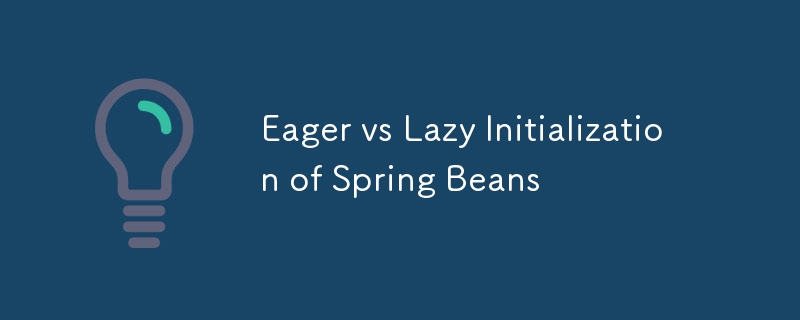
Spring에서는 기본 개념 중 하나가 Bean 초기화를 중심으로 진행됩니다. Spring Framework를 사용하여 애플리케이션을 개발할 때 Bean 초기화 eager와 lazy 중에서 선택할 수 있는 옵션이 있습니다. 둘 다 고유한 장점과 장단점이 있으며 이러한 차이점을 이해하면 애플리케이션의 성능과 리소스 사용을 최적화하는 데 도움이 될 수 있습니다.
열성적 초기화와 지연 초기화에 대해 알아보기 전에 Spring 빈이 무엇인지 간단히 살펴보겠습니다. Spring에서 빈은 단순히 Spring IoC(Inversion of Control) 컨테이너에 의해 인스턴스화, 조립 및 관리되는 객체입니다. Bean은 일반적으로 기본적으로 싱글톤이며(변경 가능) Spring 애플리케이션의 핵심 빌딩 블록을 나타냅니다.
Eager 초기화는 Spring의 기본 동작입니다. Spring의 ApplicationContext가 생성되면 구성에 정의된 모든 Bean을 즉시 인스턴스화합니다. 즉, Spring 컨텍스트가 완전히 로드되자마자 모든 싱글톤 Bean이 생성되고 해당 종속성이 주입됩니다.
다음 예를 고려해보세요.
@Configuration
public class AppConfig {
@Bean
public ServiceA serviceA() {
return new ServiceA();
}
@Bean
public ServiceB serviceB() {
return new ServiceB();
}
}
위 코드에서 ServiceA와 ServiceB는 모두 ApplicationContext가 초기화되자마자 인스턴스화됩니다. 이는 즉시 초기화가 실행되는 모습입니다.
조기 실패 감지: 모든 Bean은 시작 시 인스턴스화되므로 잘못된 구성, 종속성 누락 또는 Bean 생성 실패와 같은 문제가 즉시 감지됩니다. 이를 통해 개발 중에 문제를 더 쉽게 식별하고 해결할 수 있습니다.
예측 가능한 시작 동작: 즉시 초기화를 사용하면 모든 Bean이 미리 생성되어 애플리케이션이 시작되자마자 사용할 수 있도록 준비되므로 시작 프로세스를 예측할 수 있습니다.
시작 시간 증가: 애플리케이션에 빈과 종속성이 많은 경우 즉시 필요한지 여부에 관계없이 모든 빈이 한 번에 생성되므로 즉시 초기화를 사용하면 애플리케이션의 시작 시간이 늘어날 수 있습니다. .
메모리 사용량: 즉시 초기화하면 특히 즉시 사용되지 않는 Bean의 경우 메모리 소비가 높아질 수 있습니다. 모든 Bean은 애플리케이션 컨텍스트가 초기화되자마자 메모리를 차지하므로 특정 시나리오에서는 낭비가 될 수 있습니다.
지연 초기화는 이름에서 알 수 있듯이 애플리케이션에서 처음 요청할 때까지 Bean 생성을 연기합니다. 즉, 다른 Bean이나 애플리케이션 로직에 의해 액세스될 때만 Bean이 인스턴스화됩니다.
Spring에서는 @Lazy로 개별 Bean에 주석을 추가하거나 모든 Bean에 대해 전역적으로 지연 초기화를 설정하여 지연 초기화를 활성화할 수 있습니다.
지연 초기화를 구현하는 방법은 다음과 같습니다.
@Configuration
public class AppConfig {
@Bean
@Lazy
public ServiceA serviceA() {
return new ServiceA();
}
@Bean
public ServiceB serviceB() {
return new ServiceB();
}
}
이 예에서 ServiceA는 처음 액세스될 때까지 인스턴스화되지 않는 반면 ServiceB는 평소처럼 열심히 초기화됩니다.
시작 시간 단축: Bean은 필요할 때만 인스턴스화되므로, 특히 Bean이 많거나 초기화 로직이 복잡한 애플리케이션에서 애플리케이션의 시작 시간을 크게 줄일 수 있습니다.
메모리 효율성: 즉시 사용되지 않는 Bean은 메모리 리소스를 소비하지 않으므로 리소스가 제한된 환경이나 특정 Bean이 드물게 사용되는 경우에 유용할 수 있습니다.
지연된 실패 감지: 느리게 초기화된 Bean의 구성 또는 생성에 문제가 있는 경우 해당 문제는 Bean에 처음 액세스할 때까지 감지되지 않습니다. 이로 인해 문제 발견이 지연되고 디버깅이 더 어려워질 수 있습니다.
런타임 중 예기치 않은 지연: 게으른 Bean은 처음 사용할 때 인스턴스화되므로 Bean에 대한 첫 번째 요청으로 인해 애플리케이션이 지연될 수 있습니다. 특히 초기화 프로세스가 복잡하거나 시간이 오래 걸리는 경우에는 더욱 그렇습니다. -소비.
Spring Boot에서는 application.properties 또는 application.yml 파일에 다음 속성을 추가하여 지연 초기화를 전역적으로 활성화할 수 있습니다.
spring.main.lazy-initialization=true
When this is set, all beans in the application will be lazily initialized by default. This approach can be useful for applications with large numbers of beans that are not required immediately at startup.
Applications with Predictable Startup Requirements: If your application relies on having all beans ready immediately after startup and you want to detect configuration issues as early as possible, eager initialization is the better choice.
Small Applications: For small to medium-sized applications with a limited number of beans, the overhead of eager initialization is negligible, making it a more straightforward and predictable option.
Large Applications with Many Beans: In large applications where certain beans are rarely or never used in specific environments (e.g., certain beans are only needed for particular jobs or services), lazy initialization can optimize memory usage and improve startup times.
Performance-Sensitive Applications: If reducing startup time is a priority (for instance, in microservices where instances are frequently restarted), lazy initialization can be helpful in spreading the bean initialization load over time.
Conditional Use: If some beans are only used under specific conditions, lazy initialization can prevent unnecessary instantiation of those beans.
Choosing between eager and lazy initialization depends on your application’s needs. Eager initialization is beneficial for catching issues early and ensuring that all beans are ready immediately after startup. Lazy initialization, on the other hand, can optimize startup time and memory usage, but it may delay the detection of bean-related issues until the bean is first accessed.
By carefully considering the trade-offs, you can choose the right strategy or even mix both approaches to suit your application's specific requirements. Whether you choose eager or lazy initialization, understanding these concepts will help you optimize your Spring application and ensure that it behaves efficiently and predictably.
위 내용은 Spring Bean의 빠른 초기화와 게으른 초기화의 상세 내용입니다. 자세한 내용은 PHP 중국어 웹사이트의 기타 관련 기사를 참조하세요!